12 Best Authoring Tools for eLearning in 2025
I know how overwhelming it can be to pick the right software to build your online courses. You’re trying to create something engaging and effective, but the sheer number of options is just… a lot. That’s why I’ve spent the time digging through them all to figure out what really works.
Whether you’re a solo entrepreneur just starting out, an instructional designer building complex corporate training, or a training manager looking to scale your department’s output, this guide has an option that fits.
By the end, you’ll have a clear idea of which platform will help you bring your course vision to life without the usual headache.
Okay, now let’s find the right elearning tool for you!
1. Articulate 360
Articulate 360 is a powerhouse in the eLearning world. I often see it considered the industry standard for corporate training and comprehensive course development.
Their ecosystem includes Storyline 360 for creating highly interactive, custom courses and Rise 360 for building beautiful, fully responsive web-based training in minutes. This two-pronged approach makes it one of the best authoring tools for eLearning, catering to both quick-turnaround projects and deep, complex simulations.
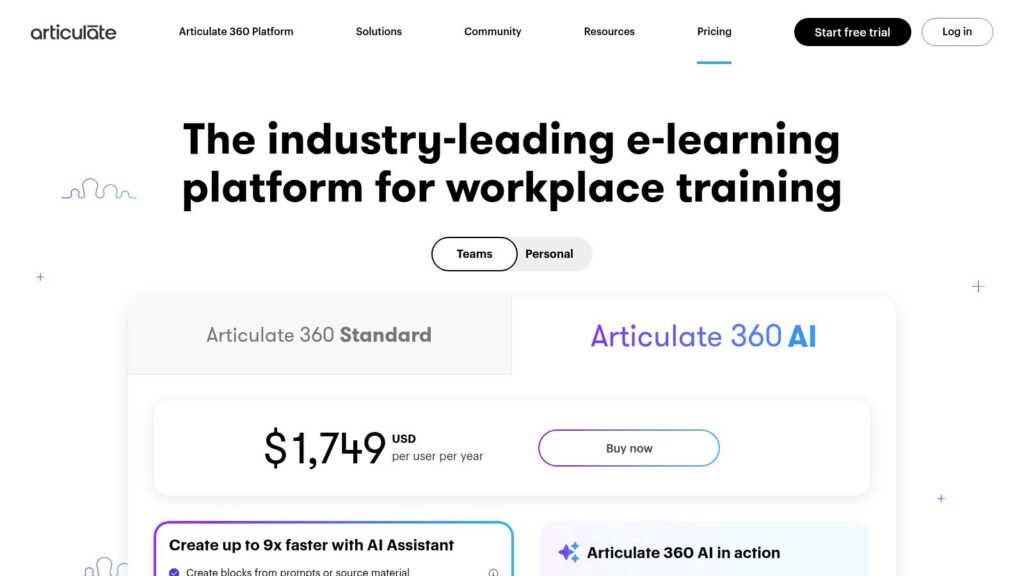
The platform streamlines the entire workflow.
Beyond the authoring tools, you get a massive library of over 13 million course assets (photos, templates, and characters) and Review 360, a web app that simplifies stakeholder feedback.
This integrated system means you can design, gather assets, build, and get approvals without ever leaving the Articulate environment.
Key Features & Use Cases
- Best for: Corporate L&D departments, freelance instructional designers, and higher education institutions that need a robust, all-in-one solution for creating professional eLearning. It’s ideal when you need to create everything from simple compliance training to complex software simulations.
- Standout Feature: The combination of Storyline 360’s power with Rise 360’s speed is its biggest strength. You can use Rise for quick, mobile-first lessons and Storyline for scenarios that require variables, triggers, and custom interactions. Properly applying these tools can significantly improve your project outcomes. For more insight into structuring these complex courses, you can explore instructional design models for eLearning.
- LMS Compatibility: Articulate excels here. It supports SCORM (1.2, 2004), AICC, xAPI (Tin Can API), and cmi5 formats for easy publishing to virtually any Learning Management System.
Pricing and Access
Articulate 360 is a premium product with pricing to match. It’s sold as an annual subscription, with separate tiers for individuals, teams, and academic users.
The main limitation is that its most powerful tool, Storyline 360, is a Windows-only desktop application. This can be a hurdle in Mac-centric organizations or those with strict software installation policies.
2. Adobe Captivate
Adobe Captivate is a veteran player in the eLearning space, long known for its powerful software simulation and screen recording capabilities.
The latest version introduces a modern, block-based authoring experience while still providing access to the “Classic” version for legacy projects.
This positions Captivate as one of the best authoring tools for eLearning, particularly for teams creating detailed software tutorials or those transitioning to more contemporary, responsive course designs.
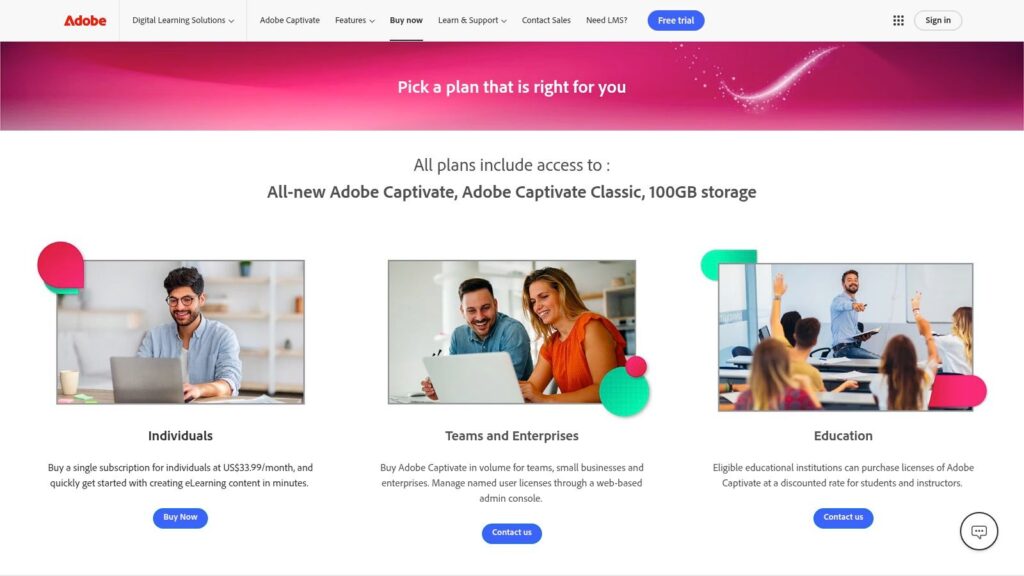
Its strength really shines when you need to create “show-me, try-me, test-me” style training.
Captivate excels at automatically generating interactive steps from a screen recording, saving developers a huge amount of time. The newer version simplifies the creation of mobile-friendly content with pre-built content blocks and design options.
In the end, this makes it more accessible for beginners without sacrificing the deep functionality that power users expect from the Adobe brand. This makes it a solid choice for a wide range of training needs.
Key Features & Use Cases
- Best for: IT departments, software companies, and instructional designers focused on creating application training and simulations. It’s also a great fit for organizations that need to produce both complex, interactive scenarios and quick, responsive courses within a single tool.
- Standout Feature: The advanced software simulation is its killer app. The ability to capture on-screen actions and instantly convert them into interactive learning modules with text captions, clickable areas, and feedback is unmatched. The new version’s focus on quick-start templates and beautiful design presets also makes it much faster to get a polished course out the door.
- LMS Compatibility: Captivate offers robust compatibility. It supports SCORM (1.2, 2004), AICC, and xAPI. This ensures your courses will report completion and scoring data correctly to nearly any major Learning Management System you use.
Pricing and Access
Adobe Captivate is available as a monthly or annual subscription, often at a more accessible entry price than its main competitors. They also offer a generous 30-day free trial to test out the full feature set.
A key consideration is that Captivate is a desktop application that must be installed on a Windows or Mac computer.
Having features split between the new, modern version and the “Classic” version can also present a learning curve as you figure out which tool is best for your specific project.
Website: adobe.com/products/captivate/buying-guide.html
3. iSpring Suite
iSpring Suite is a fantastic choice for anyone who already lives and breathes PowerPoint. Instead of forcing you to learn a complex new interface, it works as a powerful PowerPoint add-in.
This transforms your familiar slides into fully-featured, professional eLearning courses. The tight integration makes it one of the best authoring tools for eLearning if you need to rapidly convert existing presentations or build new content without a steep learning curve.
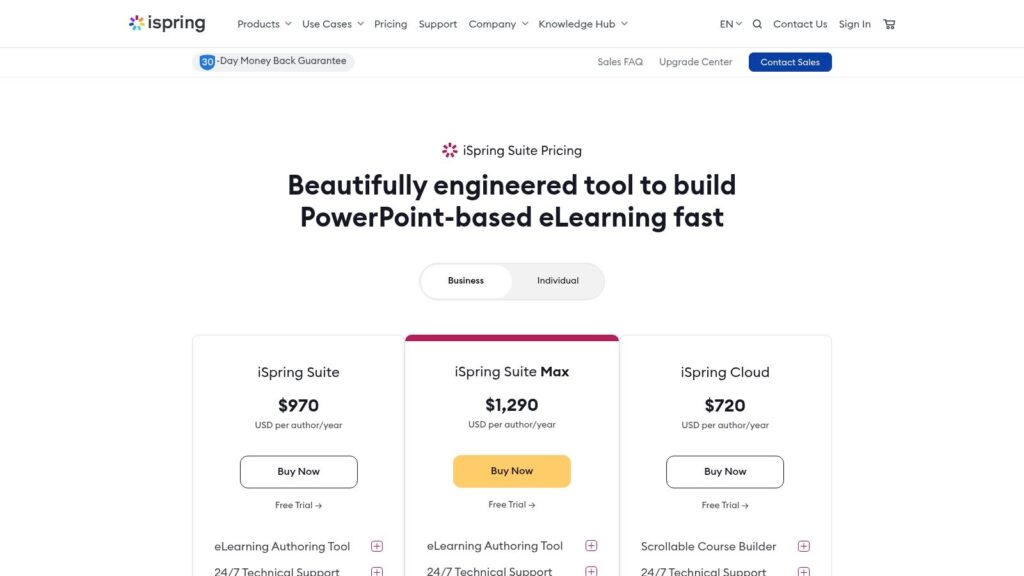
Their suite comes packed with specialized tools to elevate your content beyond simple slides.
You can build graded quizzes, create dialogue simulations for soft skills training, and record and edit video lectures directly within the platform.
For teams, iSpring Space provides a cloud-based environment to store projects and collaborate on courses, which streamlines the review and development process significantly.
Key Features & Use Cases
- Best for: Corporate trainers, educators, and subject matter experts who are proficient in PowerPoint and need to create interactive courses quickly and affordably. It’s perfect for converting instructor-led training materials into an online format.
- Standout Feature: Its seamless PowerPoint integration is the key benefit. You leverage your existing skills to build courses with advanced features like quizzes and role-play simulations. The quiz maker is particularly robust and offers great potential for engagement. This is a core principle you can explore further with ideas for eLearning gamification.
- LMS Compatibility: iSpring courses work with virtually any LMS. It publishes to all major formats, including SCORM (1.2, 2004), AICC, xAPI (Tin Can), and cmi5, ensuring your content will track and report correctly.
Pricing and Access
iSpring Suite is sold as an annual subscription and is positioned as a more budget-friendly alternative to some of the larger suites on the market.
Different pricing tiers are available for individuals, teams, and academic institutions.
A major consideration is that, like many powerful authoring tools, the core iSpring Suite is a Windows-only application. Mac users will need a Windows environment like Parallels Desktop to run it.
Website: ispringsolutions.com/pricing
4. Lectora by ELB Learning
Lectora has been a stalwart in the eLearning industry for years. It has a strong reputation for creating highly accessible and compliant courseware.
Now part of the ELB Learning family, it remains one of the best authoring tools for eLearning, particularly for developers who need deep customization and must adhere to strict accessibility standards like WCAG and Section 508.
Lectora offers both a powerful desktop version and a collaborative cloud-based version, Lectora Online, providing flexibility for different team structures and workflows.
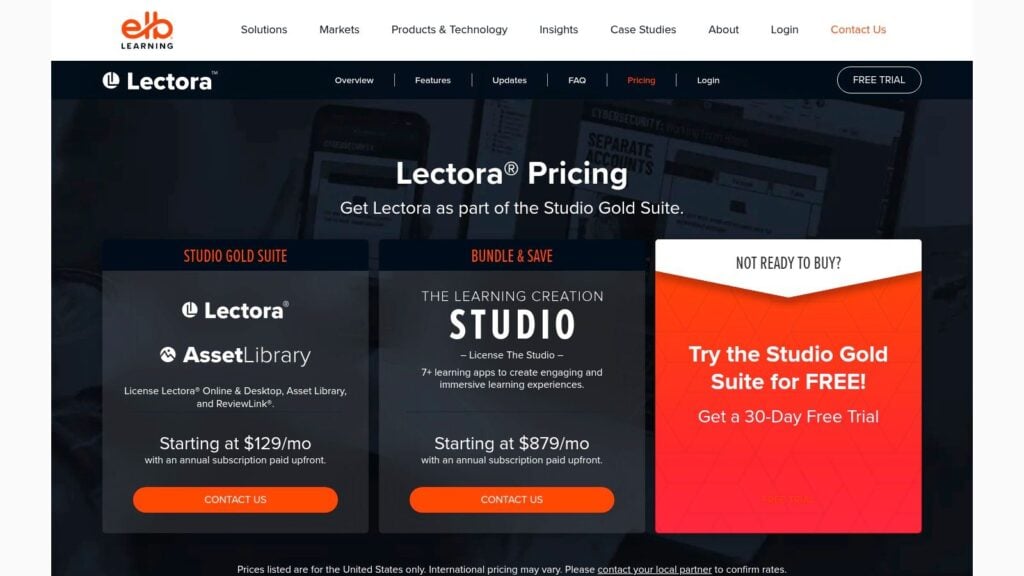
The platform is known for its open architecture. Unlike some more restrictive tools, Lectora gives developers the freedom to integrate custom scripts, external HTML, and advanced variables.
This makes it a top choice for creating complex simulations, enterprise-level training, and courses that require unique functionality not found in more template-driven tools.
When bundled with ELB’s asset library and ReviewLink, it becomes a comprehensive solution for large-scale development.
Key Features & Use Cases
- Best for: Government agencies, large corporations, and academic institutions with strict accessibility requirements. It’s also favored by experienced instructional designers and developers who want granular control over every course element without limitations.
- Standout Feature: Its unwavering commitment to accessibility (WCAG/Section 508) is its core strength. Lectora has built-in features that simplify the process of creating compliant content, such as visible focus indicators and accessible text options. This focus makes it a go-to tool for projects where accessibility is non-negotiable.
- LMS Compatibility: As an enterprise-grade tool, Lectora provides robust publishing options. It supports SCORM (1.2 and 2004), AICC, xAPI, and cmi5, ensuring smooth integration with nearly any Learning Management System.
Pricing and Access
Lectora’s pricing is tailored to enterprise needs and typically requires a conversation with their sales team.
It’s available through different subscription bundles that can include the authoring tool, an asset library, and review tools. The user interface can feel more technical and less intuitive than rapid authoring tools. This presents a steeper learning curve for beginners.
For developers who need its power, however, the investment in time and cost is often justified by the results.
Website: products.elblearning.com/create-learning/lectora-pricing
5. dominKnow | ONE
dominKnow | ONE is a powerful, cloud-based authoring platform built specifically for collaboration and scalability.
Unlike many desktop-based tools, it’s designed from the ground up for teams. This allows multiple authors to work on the same projects simultaneously.
This makes it an excellent choice for large organizations or training departments that need to manage content creation across different brands, languages, and subject matter experts.
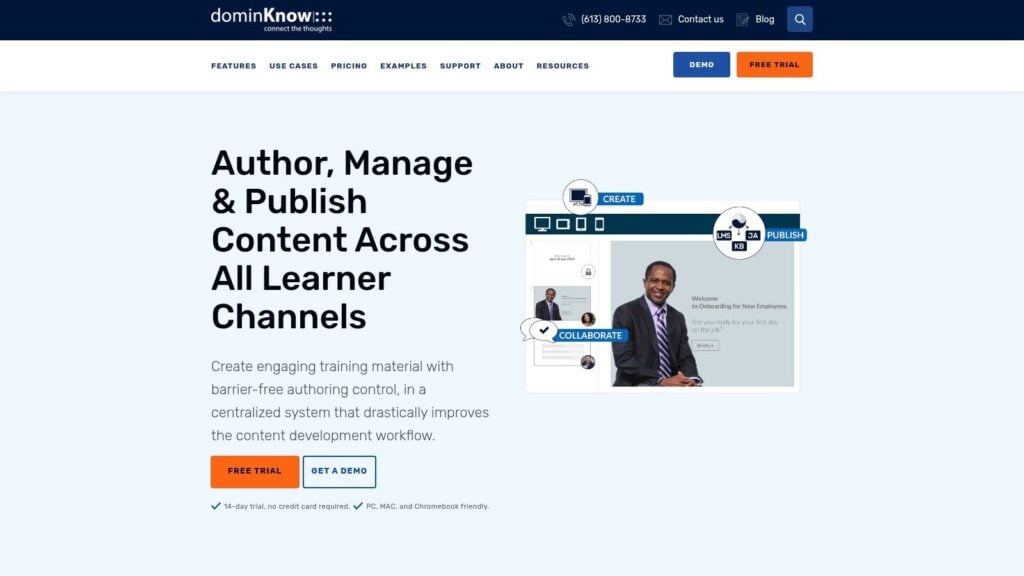
The platform’s core strength lies in its “create once, use many” philosophy.
You can build content components, like a specific interaction or a branded template, and reuse them across multiple courses. If you update the central component, it automatically updates everywhere it’s used. This saves immense time and ensures consistency.
This centralized philosophy to content management is why it’s considered one of the best authoring tools for eLearning at an enterprise level.
Key Features & Use Cases
- Best for: Enterprise-level L&D teams, global organizations with multi-language training needs, and agencies managing content for multiple clients. It shines in environments where governance, brand consistency, and content reuse are critical.
- Standout Feature: The combination of real-time co-authoring and centralized asset management is its unique selling point. Teams can build responsive courses and complex software simulations together. A robust review system also streamlines feedback and approvals. Its version control and translation workflows are also top-tier for complex projects.
- LMS Compatibility: dominKnow | ONE provides excellent support for publishing standards. It supports SCORM (1.2, 2004), AICC, xAPI, and cmi5, ensuring seamless integration with almost any Learning Management System.
Pricing and Access
dominKnow | ONE is positioned as an enterprise solution, and its subscription pricing reflects that. It’s generally more expensive than tools designed for individual creators.
The platform is entirely cloud-based, so it’s accessible on any operating system with a web browser. This is a major advantage over Windows-only applications. However, the sheer depth of its features means there is a steeper learning curve compared to simpler, more linear tools.
Website: www.dominknow.com
6. Elucidat
Elucidat is an enterprise-grade, cloud-based authoring tool. It’s built specifically for large, global organizations that need to produce high-quality eLearning at scale.
It focuses on solving the challenges of brand consistency, multi-language course delivery, and decentralized content creation. Unlike many desktop-based tools, Elucidat’s entire workflow is designed around collaboration, control, and efficiency for big teams.
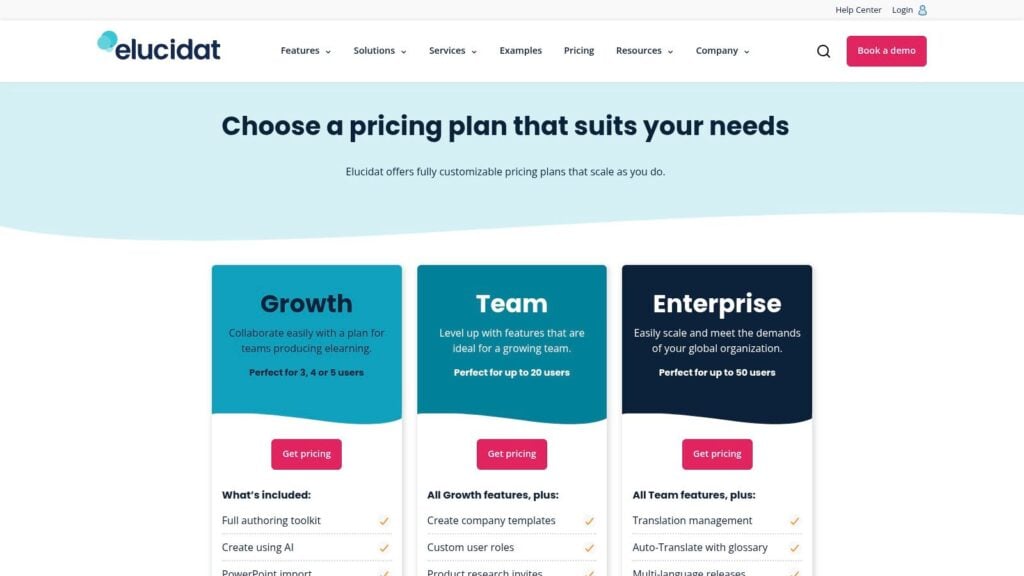
Their offering is meant to empower central L&D teams to set up branded, pre-approved templates that authors across the company can use. This ensures every course, no matter who creates it, aligns with brand guidelines.
Features like sophisticated translation management and role-based permissions make it one of the best authoring tools for elearning in complex corporate environments where governance and scale are top priorities.
Key Features & Use Cases
- Best for: Large enterprises and global businesses managing multiple brands or languages. It’s perfect for organizations that need to empower subject matter experts to create content while maintaining strict central control over quality and branding.
- Standout Feature: Its powerful localization and variations management is a key differentiator. You can create a master course and then quickly generate and manage multiple language or regional variations from that single source. This is a huge time-saver for global rollouts. The tool also excels at creating bite-sized content, which you can learn more about by exploring the top microlearning platforms available today.
- LMS Compatibility: Elucidat produces fully responsive HTML5 content compatible with SCORM (1.2 and 2004) and xAPI. It also offers a direct online release option, allowing you to bypass an LMS for certain types of training.
Pricing and Access
Elucidat is a premium, enterprise-focused solution, and its pricing reflects that. You won’t find public pricing tiers on its website.
Access typically requires a discovery call and a custom quote tailored to your organization’s size and needs. This makes it less accessible for individual creators or small businesses, as it’s designed and priced for large-scale implementation.
Website: elucidat.com/pricing
7. Gomo Learning
Gomo Learning carves out a unique space in the market. It focuses on cloud-based, collaborative authoring combined with powerful distribution options.
It’s built from the ground up to produce responsive HTML5 courses that look great on any device, from desktops to smartphones. The platform’s real magic, however, lies in its optional hosting and delivery service. This allows you to update a course once and have those changes instantly reflected everywhere it’s deployed.

This centralized update feature makes Gomo one of the best authoring tools for elearning if you manage content across multiple LMS platforms or need to deliver training directly to users via web links or an app. The collaborative, cloud-based workflow means your entire team can work together on projects simultaneously. That’s a huge plus for global or remote teams.
Key Features & Use Cases
- Best for: Large organizations with a global workforce, companies that need to distribute the same course across multiple platforms, and teams that require strong collaborative features. It’s excellent for managing a large library of evergreen content that requires periodic updates.
- Standout Feature: The Gomo Delivery and Hosting service. Instead of exporting a SCORM file for every LMS, you can use a small “Gomo wrapper” that points to the centrally hosted course. When you update the main course in Gomo, every instance updates automatically. This saves countless hours of administrative work.
- LMS Compatibility: Supports SCORM (1.2, 2004) and xAPI (Tin Can API) for traditional LMS integration. Its unique delivery model also allows for distribution outside of an LMS, with detailed analytics still captured.
Pricing and Access
Gomo’s pricing is geared towards enterprise clients and is not publicly listed. You’ll need to contact their sales team for a custom quote.
The platform is offered in different tiers, allowing you to choose an authoring-only package or combine it with their hosting and analytics services. Because it’s a fully cloud-based tool, it’s accessible from any modern web browser on any operating system. This makes it a flexible choice for both Mac and PC environments.
Website: gomolearning.com/pricing
8. Easygenerator
Easygenerator positions itself as one of the best authoring tools for eLearning by empowering subject matter experts (SMEs) directly. It is designed for speed and simplicity. It enables people without a background in instructional design to create, update, and share effective training materials quickly.
Easygenerator is a fully cloud-based tool that strips away the complexity often associated with powerful authoring software, focusing on a user-friendly, template-driven experience.
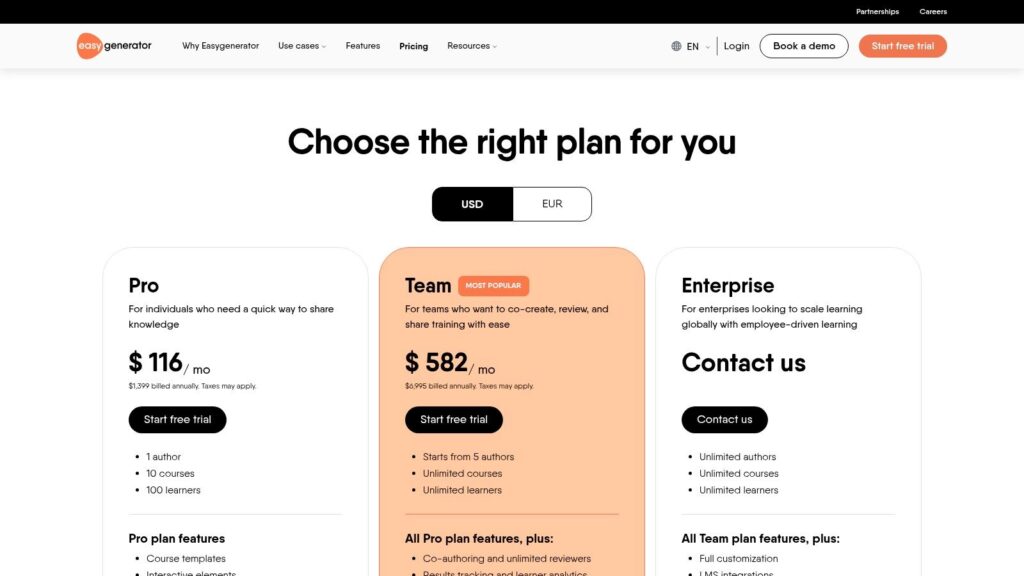
The core idea behind Easygenerator is decentralized content creation. Instead of having a small L&D team as a bottleneck, you can give your internal experts the tools they need to build courses themselves.
This approach is perfect for rapidly changing information where speed to deployment is critical. It’s a great way to capture and share knowledge that exists throughout your organization.
Key Features & Use Cases
- Best for: Organizations looking to decentralize course creation and enable SMEs to build their own training. It’s also a strong choice for small to mid-sized L&D teams needing a fast, low-learning-curve tool for standard course development.
- Standout Feature: The “Easygenerator for Teams” model, combined with its intuitive user interface, is the main attraction. It allows you to set up collaborative workflows where SMEs create content, and instructional designers can review and co-author. This ensures quality without slowing down the process. The built-in results tracking, even without an LMS, is a huge plus.
- LMS Compatibility: Courses can be exported as SCORM (1.2 and 2004), xAPI, and LTI for use in any standard LMS. Alternatively, you can share a private link directly with learners, which is great for informal learning or organizations without an LMS.
Pricing and Access
Easygenerator offers Pro and Team subscription plans, making it a more accessible option compared to large enterprise suites. The value is particularly strong for teams.
However, be aware that key features like advanced collaboration, in-depth analytics, and branding customization are reserved for the higher-priced Team plan. Its cloud-based nature means it works on any operating system, but its interactivity options are not as extensive as desktop-based tools like Storyline.
Website: https://www.easygenerator.com/pricing/
9. Evolve Authoring
Evolve Authoring is a modern, cloud-based authoring tool that truly shines in creating visually polished, mobile-first courses.
It’s built from the ground up for teams who need to deliver beautiful, responsive HTML5 content at scale. Unlike some traditional tools, Evolve focuses on a component-based design approach.
This means you can build courses quickly by stacking and customizing interactive elements. It’s a fantastic choice for brands that prioritize a sleek, consistent user experience across all devices.
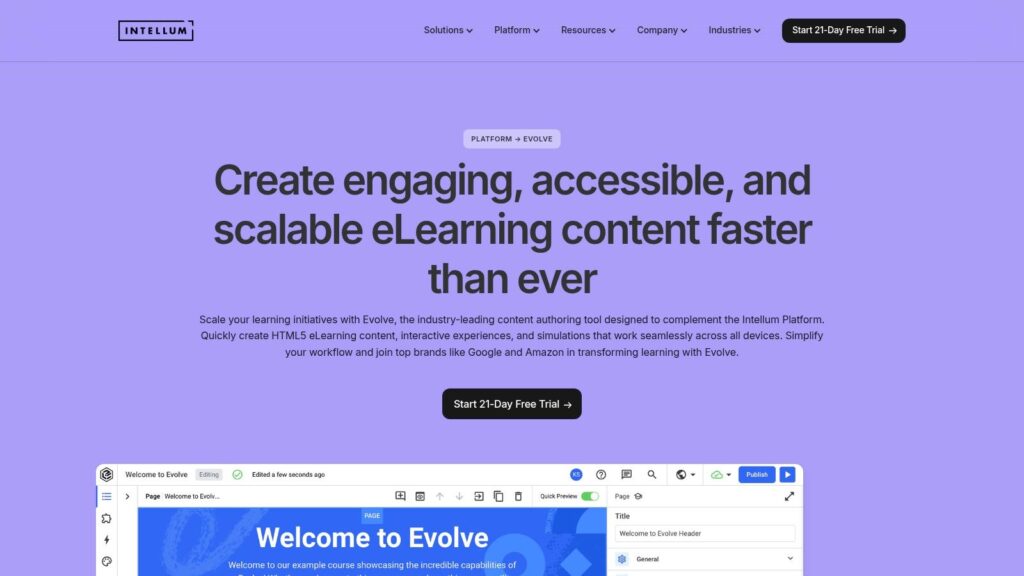
The platform is designed with collaboration in mind. Its strong roles and permissions system allows large teams of developers, designers, and subject matter experts to work together seamlessly within the same project.
This focus on workflow makes it one of the best authoring tools for eLearning development in larger organizations or agencies managing multiple client projects, ensuring both speed and quality control.
Key Features & Use Cases
- Best for: Corporate teams and digital agencies that need to produce high volumes of stunning, fully responsive content. It’s especially effective for performance support and modern compliance training where aesthetics and mobile accessibility are non-negotiable.
- Standout Feature: The robust component library combined with powerful theming capabilities is Evolve’s main strength. You can rapidly assemble courses using pre-built interactions like interactive video, branching scenarios, and knowledge checks. Then you can apply a custom theme to ensure every course perfectly matches your brand guidelines.
- LMS Compatibility: Evolve provides solid support for SCORM 1.2 and SCORM 2004, covering the needs of most corporate learning environments. It also allows for offline web exports, giving you flexibility in how you distribute your content.
Pricing and Access
Evolve is part of the Intellum platform, and its pricing is geared toward enterprise clients. You typically need to contact their sales team for a custom quote, as pricing is not listed publicly on the main site.
While it functions powerfully as a standalone tool, be aware that unlocking its most advanced enterprise features and analytics often requires deeper integration with the full Intellum ecosystem. This could be a consideration for teams not already using or planning to adopt that platform.
Website: www.intellum.com/platform/evolve
10. H5P.com
H5P.com is not a traditional, all-in-one course authoring tool. Instead, it offers a powerful library of over 50 embeddable, interactive content types that you can add to existing platforms.
Think of it as a toolkit for injecting engagement into your lessons, from interactive videos and branching scenarios to flashcards and complex quizzes. It is one of the best authoring tools for eLearning if your goal is to enhance, not replace, your current ecosystem.

The platform shines in its simplicity and reusability. You build an interactive element once and can embed it anywhere: in your LMS, on a WordPress site, or any other platform that supports embeds.
The magic is that H5P content is built on open-source HTML5, making it universally compatible and responsive without any extra work.
Key Features & Use Cases
- Best for: Educators and trainers who are already happy with their LMS or website but want to quickly add rich, interactive activities without a steep learning curve. It’s perfect for creating standalone learning objects that can be shared and reused across different courses.
- Standout Feature: The seamless LMS integration via LTI (Learning Tools Interoperability) is a game-changer. This allows you to embed H5P activities directly into platforms like Canvas, Moodle, or Blackboard. More importantly, it lets the activity send grade and completion data back to the LMS gradebook, creating a truly integrated experience.
- LMS Compatibility: As an LTI provider, H5P.com is designed to work with virtually any modern LMS. It also supports xAPI, allowing for detailed tracking of learner interactions.
Pricing and Access
H5P.com operates on a tiered subscription model based on the number of authors and learners. There is no plan for a single author.
The pricing starts with small team plans, making it more suited for institutions and businesses rather than individual freelancers. Its primary limitation is that it’s not a full course builder.
You can’t create a complete, standalone SCORM package with a menu and navigation like you would in Storyline. It’s a tool for creating content within a larger course structure.
Website: h5p.com/pricing
11. ActivePresenter
ActivePresenter by Atomi Systems is a powerful all-in-one screen recorder, video editor, and eLearning authoring software.
Its biggest differentiator in a sea of subscription services is its perpetual license model. This makes it an incredibly attractive option for educators, small businesses, and freelancers who need robust features without the recurring monthly cost. It’s particularly strong for creating software tutorials and video-based training.
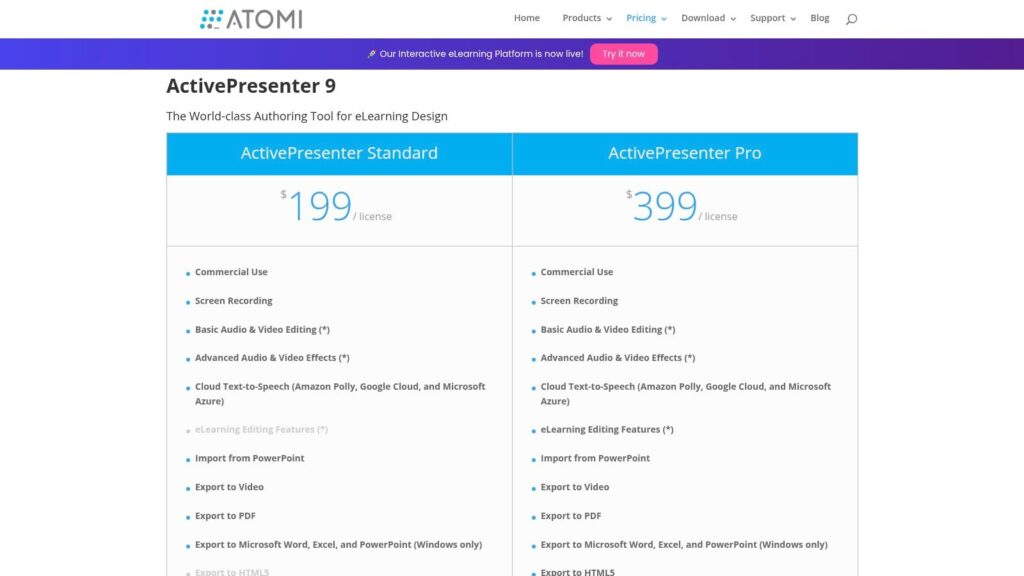
They combine high-fidelity screen recording with a surprisingly capable multi-track video editor and the ability to add interactive elements.
You can build quizzes, use variables for branching scenarios, and create responsive content that works across devices. For those on a tight budget who still need professional output, ActivePresenter is one of the best authoring tools for eLearning available.
Key Features & Use Cases
- Best for: Creating software simulations, video-centric training modules, and academic tutorials. It’s a great fit for users who prioritize a one-time purchase over a subscription and need strong video editing capabilities built directly into their authoring tool.
- Standout Feature: The combination of screen recording, video editing, and interactive authoring in a single application is its core strength. You can record a process, edit the video with annotations and effects, and then layer interactive questions or branching paths on top of it, all without switching programs.
- LMS Compatibility: The tool is fully compliant with modern learning standards. It offers export options for HTML5, SCORM (1.2, 2004), and xAPI (Tin Can API). This ensures your courses will track correctly in most Learning Management Systems.
Pricing and Access
ActivePresenter offers a free version with a watermark, which is great for trying it out. The paid versions, Standard and Pro, are available as a one-time purchase with an optional maintenance plan for future upgrades.
The Pro plan unlocks all the interactive eLearning features. A notable limitation is its smaller ecosystem. You won’t find the massive built-in asset libraries or dedicated review platforms that come with tools like Articulate 360.
Website: atomisystems.com/pricing/
12. G2 – Course Authoring Software Category
While not a creation tool itself, G2’s Course Authoring category is an essential research hub that belongs in every instructional designer’s toolkit.
I think of it as a meta-tool for finding the right authoring platform. G2 aggregates real user reviews, feature comparisons, and satisfaction scores for dozens of the best authoring tools for eLearning.
Then it presents them in a filterable grid. You can sort by company size, user ratings, and other factors to see how tools stack up against each other in the real world.
This platform provides a layer of social proof that vendor websites simply cannot offer. Instead of relying on marketing copy, you can read detailed pros and cons from people who use these tools every day. This insight is invaluable for vetting options, discovering new contenders, and making a confident purchasing decision based on crowd-sourced data.
Key Features & Use Cases
- Best for: Anyone in the market for a new authoring tool. It’s a critical first stop for L&D managers, freelance designers, and course creators who need to build a shortlist, compare features, and understand the market landscape before committing to demos or trials.
- Standout Feature: The “Compare” functionality is its greatest asset. You can select up to four tools and see a side-by-side breakdown of user satisfaction ratings across key areas like ease of use, quality of support, and ease of setup. This makes it easy to spot where a popular tool might fall short for your specific needs.
- LMS Compatibility: Not applicable directly, but user reviews often contain valuable, real-world feedback on how well specific authoring tools integrate with various Learning Management Systems.
Pricing and Access
G2 is completely free to use for research and comparison. The platform makes money through sponsored placements and by selling market intelligence reports, but its core comparison grids and reviews are accessible to all.
The main limitation is that the information, particularly pricing, can sometimes lag behind official vendor updates. Always cross-reference pricing on the vendor’s site before making a final decision.
Website: g2.com/categories/course-authoring
Top 12 eLearning Authoring Tools Comparison
| Tool | Core Features | Target Audience | Unique Selling Points | Price & Trial |
|---|---|---|---|---|
| Articulate 360 | Full suite, LMS support, collaboration | Enterprises, teams | Large asset library, AI authoring option | Higher price, 30-day free trial |
| Adobe Captivate | Software simulations, responsive design | SMEs, software trainers | Combines modern & classic tools | Lower monthly cost, 30-day trial |
| iSpring Suite | PowerPoint integration, quizzes, cloud | Budget-conscious creators | Tight PPT integration, online collaboration | Lower cost, responsive support |
| Lectora | Desktop & online, strong accessibility | Accessibility-focused orgs | WCAG/508 compliance, scripting | Pricing varies, sales required |
| dominKnow | ONE | Scalable, enterprise governance | Large teams & multi-brand | Multi-author, translation workflows |
| Elucidat | AI authoring, multi-language, analytics | Large teams, enterprises | Brand/localization scale, ISO compliance | Higher price, sales required |
| Gomo Learning | Responsive authoring, hosting & delivery | Enterprises | Centralized updates, multi-channel | Enterprise pricing, sales contact |
| Easygenerator | Cloud-based, templates, SCORM export | SMEs, L&D teams | Fast setup, good value for teams | Moderate price, limited free tier |
| Evolve Authoring | Mobile-first, component-based courses | Brands scaling content | Strong theming, offline exports | Pricing not fully public |
| H5P.com | 50+ interactive types, LMS integration | Educators, LMS users | Embeddable, LMS-friendly, AI-assisted import | Multi-author plans, no single plan |
| ActivePresenter | Screen recording, quizzes, responsive | SMBs, educators | Perpetual license, strong value | One-time license, affordable |
| G2 | Market comparison, user reviews | Buyers researching tools | Broad coverage, vendor links | Free access, pricing snapshots |
So, What’s the Next Step?
Whew, that was a lot of information, I know.
We’ve journeyed through a dozen of the top players in the course creation space. We looked at everything from the powerhouse suites of Articulate 360 and Adobe Captivate to the nimble and specific solutions offered by tools like H5P and Easygenerator.
The truth is, the search for the best authoring tools for elearning is about discovering the perfect fit for you.
Your ideal tool depends entirely on your unique context. This includes your project goals, your team’s technical comfort level, and of course, your budget.
The right choice for a large corporation with a dedicated L&D team, like Elucidat, is likely very different from the right choice for a solo course creator who needs to get a polished product to market quickly.
Finding Your Perfect Fit: A Recap
Let’s break this down.
As you reflect on the options, ask yourself a few key questions. This will help you narrow down the list from twelve to just two or three serious contenders.
Who is building the courses? Are you a team of one, or do you have a group of instructional designers, subject matter experts, and reviewers? Tools like dominKnow | ONE and Gomo Learning are built for collaboration, while something like ActivePresenter might be ideal for an individual.
What is your team’s skill level? Be honest here. If your team lives and breathes PowerPoint, a tool like iSpring Suite will feel like a natural and powerful extension. If you have developers on hand or designers comfortable with timelines and variables, then Articulate 360 or Adobe Captivate unlock a new level of possibility.
What kind of courses are you building? Are you focused on creating highly interactive, custom-branded scenarios and simulations? Lectora or Captivate might be your go-to. If your primary need is converting existing documents and presentations into clean, responsive web-based training, then a tool like Easygenerator could be the fastest path to success.
Where will learners access the content? In today’s world, the answer is almost always “everywhere”. Most tools we discussed offer strong responsive design, but it’s worth double-checking how they handle mobile-first versus desktop-first authoring.
Your Actionable Next Steps
Information is great, but action is better. Don’t get stuck in analysis paralysis. Here’s what you should do next to make a confident decision.
- Shortlist Your Top 3: Based on the questions above, pick the three tools that seem most aligned with your needs. Don’t overthink it. Just go with your gut feeling after reading the deep dives.
- Commit to the Free Trial: This is non-negotiable. Every major platform offers a free trial or a demo for a reason. Marketing materials can only tell you so much. You need to get your hands dirty and actually use the software.
- Build a “Test” Project: Don’t just click around aimlessly during your trial. Come prepared with a small, real-world project. Try to build one or two slides or a short module from an actual course you need to create.
- Try to import your brand assets (logo, colors, fonts).
- Attempt to build a common interaction you use, like a tabbed interaction or a simple quiz.
- Publish or preview the project to see how it looks and functions on both a desktop and a mobile device.
The best authoring tools for elearning are the ones that empower you to bring your vision to life without adding unnecessary friction.
I hope this comprehensive guide has illuminated the path forward for you. Now, go sign up for a couple of trials and start building. Happy creating






